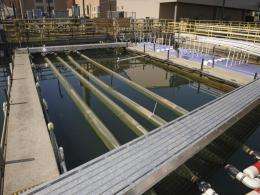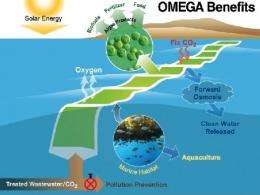NASA showcases method to grow algae-based biofuels

NASA recently showcased the latest research and technology development a method to grow algae, clean wastewater, capture carbon dioxide and ultimately produce feedstock for refining biofuels without competing with agriculture for water, fertilizer, or land.
NASA’s unique floating algae cultivation system, called Offshore Membrane Enclosure for Growing Algae (OMEGA), managed by NASA’s Ames Research Center, Moffett Field, Calif., will be available to transfer to the commercial sector in May 2012. Members of the algae-for-biofuel community and industry are invited to take the OMEGA concept and further explore its potential commercial applications.
A small-scale OMEGA system was developed in seawater tanks at the California Fish and Game laboratory in Santa Cruz, Calif., and scaled up to a 450-gallon system at the Southeast Wastewater Treatment facility in San Francisco.
The OMEGA system is designed to grow freshwater algae in municipal wastewater using NASA’s photobioreactors, which are flexible plastic tubes that float in seawater. In the process of growing, the algae treat wastewater and address environmental problems by consuming nutrients from the wastewater and carbon dioxide. The nutrients, if left unconsumed, would otherwise be released into the coastal waters contributing to undesired algae blooms. Just like shrubs and trees, algae have an appetite for the greenhouse gas, carbon dioxide. The algae release oxygen into the air as they absorb carbon dioxide, retrieve their nutrients from wastewater, and use energy from the sun to grow. These tiny single-cell algae are the fastest growing plants on the planet.

Depending on the amount of sunlight, nutrients, water temperature and a few other environmental conditions, algae can double their numbers every day and be ready to harvest in just three to five days. Some kinds of algae make oil, which can be converted into environmentally friendly and sustainable biofuels. In addition, the remains of the algae, after removing the oil, can be used to produce other products, such as fertilizer, natural gas, and animal feed.
Among other research results to be published in May, the OMEGA research team demonstrated that the floating plastic tubes of algae pose no apparent threat to marine animals in a set of small-scale experiments.
"We have continuous video of various prototypes of photobioreactors, day and night, over a six-month period. We see birds and sea otters interacting with the system, but it does not impact their well being," said Jonathan Trent, the project scientist of the OMEGA at NASA Ames. "Preliminary data showed that the interactions of these animals are not problematic to the system or its functions. "
In developing OMEGA, scientists were inspired by NASA’s closed life support systems used on the International Space Station that optimize the use of resources and minimize waste. OMEGA focuses on self-sustaining cycles that convert waste from one part of the system into assets for another part. NASA used its unique expertise in life support systems to develop the OMEGA technology and lower the potential technical risks to the private sector looking to pursue larger-scale systems.
”We’ve addressed some of the more daunting technological problems for implementing OMEGA,” said Trent. “Now the hope is that other organizations and industries will realize the potential of the OMEGA technology for wastewater treatment and ultimately to produce sustainable biofuels.”
Provided by JPL/NASA

















